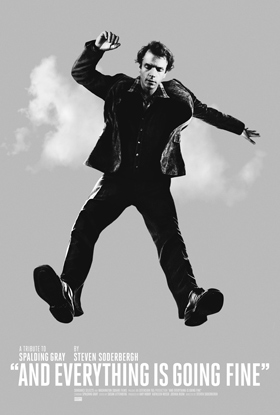
A Review of Stephen Soderbergh’s And Everything is Going Fine
Written by: Pat King, Special to CC2K
 CC2K’s Pat King gives Stephen Soderberg’s documentary a thumbs-up.
CC2K’s Pat King gives Stephen Soderberg’s documentary a thumbs-up.
And Everything is Going Fine is Stephen Soderbergh’s documentary on the life of playwright, monologist and actor Spalding Gray. The movie made the festival rounds last year and is now available on IFC on Demand.
This is a strange sort of talking head doc. For the most part, only Gray does any talking. There’s almost no B-roll and none of Gray’s family members or friends were interviewed (though Gray’s son does provide the musical score). In fact it’s entirely composed of archival footage. No new material was shot. The movie is a sort of greatest hits compilation of Gray’s autobiographical monologues spliced with various interviews taken from TV news programs like The Charlie Rose Show.
There was plenty of footage for Soderbergh to choose from. A bunch of Gray’s monologues were videotaped for posterity and they range in quality from very good to only just decent. I really didn’t get a good sense of what a complete Gray monologue was like because we jump pretty quickly between performances. We might be watching something shot in the early 80’s only to have it suddenly switch to video from the 90’s. This was done so that Gray’s autobiography could be presented in chronological order. The structure works and combined with the interviews, which are more casual and naturally less theatrical than the performances, we get a pretty good biographical sketch of the guy. We hear about his childhood first, about his Christian Scientist mother and her descent into madness and eventual suicide. Then we hear about his father’s subsequent quest to bring order to his life by buying and designing the perfect 1960’s dream home with his next wife. Gray also discusses his stage acting career, which he’s never totally satisfied with, and his various relationships and affairs with women and his experimentation with homosexuality. Finally, Gray talks about his unexpected fatherhood and a terrible car accident in 2001 that left him a shattered and beaten man. The film’s structure, that of a sort of posthumous autobiography, prevents the possibility of Gray talking about his death by suicide in 2004. Sodherbergh’s decision not to even mention it in the closing credits is a little perplexing, what with all the biographical information we get in the film. Still, it’s kind of admirable that he stuck to his aesthetic to the end, audience be damned.
Gray’s monologues were hyperbolic, ironic and cutting. His humor was self-depreciating and very, very dark. His performances relied almost entirely on his ability as a storyteller. They had to. Gray usually just sat at a table, telling his stories. There’s often little more than a glass of water and a notebook for props.
I think this movie’s definitely worth watching. Gray left plenty of performances and books behind and this film has at the very least inspired me to dig deeper into his work. Maybe it will for you too.
